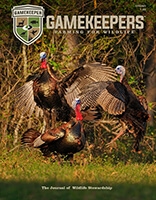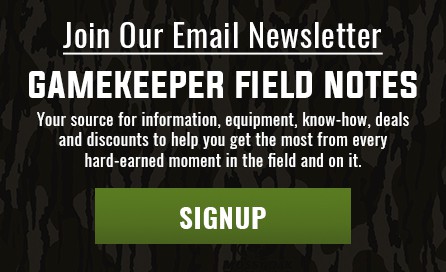Properly applied, an antlerless deer license is a highly effective tool for managing deer populations, which can lead to a healthier deer population and an improved buck-to-doe ratio. Please note the critical first two words of this paragraph: “properly applied.” We, hunters, manage wildlife populations, not the bureaucrats in wildlife management. We pull the triggers. To manage whitetail deer wisely, we should be fully informed about their innate natural history and reproductive dynamics. These natural facts are unchangeable and particularly vital to effective deer management.
Curiously, deer biologists rarely speak of a unique and vitally important trait of deer reproduction. That biological fact is that a doe fawn/yearling will produce a single fawn on or near her first birthday. The probability of that first fawn being a buck is nearly ninety percent! This biological fact applies to both captive and wild deer herds. After decades of working with multiple whitetail deer propagators, I have come to understand that this dynamic is an accepted and dependable fact. Recently, a large-scale deer propagator confirmed that this natural phenomenon is at least seventy-five percent dependable. That is seriously substantial.
Subsequent fawnings by adult does regularly produce twins. Twin fawns can include both sexes or twin does, but rarely twin bucks. Adult does are notably larger than their immature offspring. That large, mature doe is the key animal to be selectively culled from the herd.

Timothy C. Flanigan
Deer numbers are usually controlled by issuing a limited allocation of antlerless deer licenses. Please note that “antlerless” does not mean female; it means any deer without visible antlers. The ultimate goal of an antlerless license holder is to harvest pounds of venison for the family table. Therefore, pulling the trigger on a small, immature deer with very little venison on its skeleton is foolish. Selecting a large adult antlerless deer upon which to hang a tag is common sense; more meat in the freezer. It is also wise deer management, and here’s why.
Taking the old or mature doe helps control the overall deer population by reducing the number of multiple births and permits the young of the year to survive. That enables the button buck to escape harvest and the doe fawn to produce a buck fawn in the spring. Hunters need only take a little closer look to evaluate the target before applying knowledgeable trigger-finger deer management.
It is important to remember that an adult doe may be accompanied by a single male fawn, her first-born buck. She is the correct candidate for your antlerless deer tag. Her subsequent pregnancy will almost certainly produce twin fawns. A closer look at deer is fascinating and enjoyable, and there is rarely a need to rush a shot during antlerless deer hunts.
The informed hunter will notice that fawns have shorter, stubbier noses than their adult parents. Button bucks have noticeably flat heads even though the buttons, or antler pedicles, are probably not yet visible. Does have noticeably rounded heads, and doe fawns are nearly always larger than their little brothers. These disparities are readily noticeable.
In many states, antler restrictions require deer hunters determined to harvest a buck to look closer at their intended quarry before pulling the trigger. Such regulations have proven beneficial in increasing the quality of local buck populations. Therefore, it is reasonable to encourage the antlerless deer hunter to be selective. In actuality, selective doe harvest can impact a deer herd much more significantly than selective buck harvests.
Additionally, special seasons, such as archery or muzzleloader deer hunts, often begin well before the fall or winter rifle seasons. The disparity between fawns and adults, doe fawns, and button bucks is readily discernible during the earlier seasons. The naïve fawns are especially vulnerable then, and their ordinarily ultra-alert adult mother is less so at the advent of the early seasons. This permits ample time for that closer look and selective shooting that will put more pounds of prime venison in the freezer and encourage a healthy deer herd.

Timothy C. Flanigan
If you’re skeptical, consider the following true story of deer management success that astounded a local community and was quickly adopted by successive farm neighbors, where it was proven.
While working as a wildlife professional, I had the opportunity to explain this deer harvest strategy and its deer reproduction basis to a young man who had taken control of the family farm, and immediately began a deer-killing spree that knew no bounds.
His wanton killing under the guise of “crop damage” gained his neighbors’ disdain, who complained of poor deer hunting. He, too, complained about the poor quality of the bucks on his farm and blamed it on hunters who frequented the state land bordering it.
Eventually, a confrontation occurred. One night, he killed and kept an outstanding trophy buck. The kill was permitted, but the law prohibited the retention of deer antlers and hides. An angered family member informed on him, and I seized the exceptional buck head that he’d tried to conceal. His loss was traumatic, but it led to lengthy discussions about deer reproductive dynamics and buck maturity rates. I emphasized the wisdom of selectively harvesting only adult female deer as the most effective control of crop damage and issued only a warning for his law infraction.
From then on, he killed only adult female deer to control crop damage. He also restricted his family and guest hunters to an eight-point or more significant buck rule and enforced it by denying hunting privileges to anyone who violated it. Within three years, his cousin killed a record-book archery buck on the farm, and he took two trophy bucks. Five years into his adult doe-only, crop-kill strategy and antler restrictions, he gave me a videotape.
He answered my query about its content with, “Remember those talks we had? Well, I’ve been doing what we discussed for five years now; look at the tape see what I’ve got on the farm now.”
The video was astounding. The young farmer had climbed atop one of the farm’s implement shed roofs and filmed the deer coming into his rich alfalfa field as daylight faded into a September night. The first deer to enter the field at dusk was a respectable 6-point. Followed by a succession of bucks and a few does. As daylight faded, three truly exceptional trophy bucks appeared. Seventeen of the twenty-two deer in the field were legal bucks according to state laws, a six-point being the smallest.
After watching the video, I invited this young farmer to attend the local Conservation District’s Deer Damage Committee meeting, which was imminent. Nearly everyone in attendance recognized this young farmer and wondered why someone with his reputation for excessive deer killing had been invited to address this conservative group. I began my portion of the meeting by playing his unique video. The room fell silent until one incredulous farmer asked, “Okay, where is this? Out west somewhere? It sure as heck ain’t around here!”
The young farmer stood and said proudly, “That’s my farm from last week.” A flood of questions ensued, and he eagerly described his five-year program that had produced this bounty of quality bucks. He explained how removing only adult female deer reduced the herd and lessened crop damage, while increasing the buck-to-doe ratio. I could not have done it better.
His fellow farmers were skeptical. To counter their doubt, I explained the wisdom of selecting only the adult doe deer to fill an antlerless tag. “Never shoot a small deer. There is much more meat for the table on an adult doe, and the adult nearly always produces twin fawns. If you let her twin fawns pass, the yearling doe fawn will almost certainly birth a single buck fawn in the spring. If you let the buck fawn pass, he may become a trophy. In the process, you reduce the overall deer numbers, limit the pressure on food resources, and enhance the buck/doe ratio.
Several neighboring property owners followed the young farmer’s lead, with similar results. The ultimate key to this success is maintaining a young deer herd by selectively harvesting adult females, avoiding fawn kills, and allowing bucks to mature. Taking a closer look before tagging an antlerless deer also increases hunter safety. What a superb and fitting bonus.
The hunter’s vital role in deer management is generally beneficial when applied wisely. “If it’s brown, it’s down” is a fool’s phrase that betrays a greedy and unsafe attitude. On the opening morning of what was traditionally the “buck season” of my retirement as a Pennsylvania Wildlife Conservation Officer, I stopped at a convenience store for a coffee. This year, hunters could fill their antlered deer tags and antlerless deer tags during the annual deer rifle season.

Linda arndt
Upon exiting the convenience store with a steaming cup in hand, I heard a fellow yell, “Hey. What-da-ya think of my buck?” That drew my attention to a fellow standing beside an SUV with three deer strapped to its roof. Two were tiny and barely visible beside the buck. His uplifted right hand gripped the antlers of a good whitetail buck. “What-da-ya think of my buck?” He repeated. I approached him to admire the deer and complimented him on its quality. He was rightfully proud of his “Thirteen-pointer.”
“He’s nice. Congratulations on a trophy. What do you have over here?” I asked and walked to the passenger side of his vehicle. There, atop the SUV, lay two minuscule button bucks, the smallest I’ve seen during a lifetime of hunting and thirty years as a Wildlife Conservation Officer. “What happened here?” I asked with raised eyebrows.
Well, you know, if it’s brown, it’s down. I shot one; my brother shot the other. They’re both bucks, though,” he said proudly. I cringed and shook my head in disgust. “They came along right after I shot my buck, and we had tags, so we shot ’em.”
Upon learning the location of their hunt, I commented, “That’s private property. Did you have permission to hunt on the Johnson farm?” “No, but there ain’t no posted signs there,” he responded. “You know what you did here, don’t you? I asked. “Yeah, we’ll have to hunt somewhere else next year. Those are probably his fawns.” He added.
“Yes,” I agreed, adding, “They might have grown to be better than your thirteen-pointer.” His brother’s eyes and mine met as he exited the store, causing him to turn about and reenter the building. He, too, realized the folly of two unwise trigger pulls.
-
Join our weekly newsletter or subscribe to Gamekeepers Magazine.
Your source for information, equipment, know-how, deals and discounts to help you get the most from every hard-earned moment in the field.









